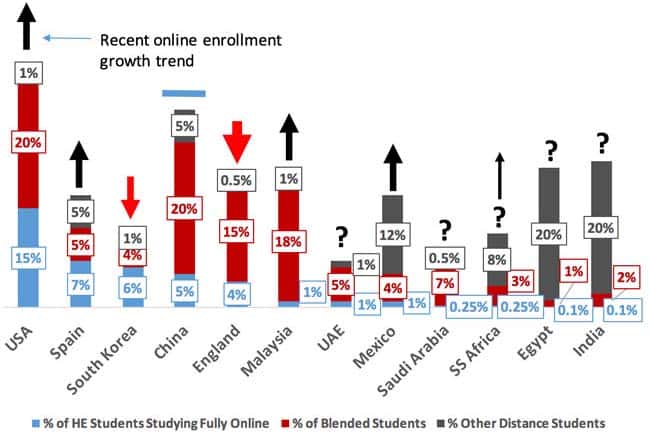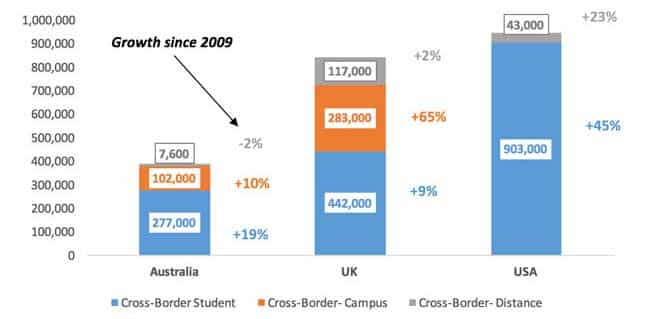Study explores adoption of online learning and its relationship to student mobility
“Online learning – the use of the Internet to provide or augment formal education – has grown up. Still viewed as novel or innovative in some quarters, online learning can now look back on an almost thirty-year history.” This statement opens an important new study from the Observatory on Borderless Higher Education (OBHE), and it kicks off a wide-ranging survey of the scale and shape of online learning in key markets around the world. In Whatever Happened to the Promise of Online Learning? The State of Global Online Higher Education, the OBHE sets out case studies for 12 selected countries and regions, and finds widely varying rates of adoption and experiences of online learning across this sample:
- China
- Egypt
- England and Scotland
- India
- Malaysia
- Mexico
- Saudi Arabia
- South Korea
- Spain
- Sub-Saharan Africa (excluding South Africa)
- United Arab Emirates
- United State of America
The study places these markets into one of five descriptive categories as follows:
- “Distance, Not Online.” These markets have a large distance learning sector but one that makes little use of of online learning (e.g. Egypt, India).
- “Online Learning as Marginal.” These education systems are characterised by strong growth in enrolment on campus, but with very modest use of online learning (e.g. Saudi Arabia, UAE and Sub-Saharan Africa).
- “Blurred Growth.” The OBHE considers that these countries have a muddled online learning context, with elements of distance learning, that nevertheless is growing more quickly than conventional delivery modes (e.g. Mexico, Spain).
- “Clear Online Growth.” As distinct from “Blurred Growth” markets, these countries feature a clearly defined online learning sector that is growing more quickly than campus-based programming (e.g. United States).
- “Peaked/Decline.” Countries belonging to this final group have seen their online enrolment flatten or even decline in recent years (e.g. England, South Korea).
Keeping those broad categorisations in mind, the following chart provides a summary of the market share of online learning, and recent growth trends, for the 12 case study countries and regions.

The connection to international mobility
Of particular relevance to international recruiters, the study also considers the extent of online provision across borders – that is, the scale of “virtual international mobility” where students pursue online programmes offered by an institution overseas.
“[One] strand of dotcom-era enthusiasm for online learning was the notion that the technology would disrupt national higher education systems, prompting large virtual student flows across country borders,” says the study report. “Champions foresaw in online learning a way to dramatically increase access to high quality programming, addressing absolute capacity limitations in some countries and quality or cost restrictions in others.”
Even acknowledging that data on cross-border enrolments is limited in many markets, the OBHE finds little evidence of growth in this area. Looking back over a decade or more, total growth in international mobility has been significant, and the volume and variety of transnational education has also expanded considerably via more conventional modes such as international branch campuses and joint or dual degree programmes.
In the following chart, we see this pattern playing out through the examples of Australia, the UK, and the US as it tracks the volume of higher education provision for inbound cross-border students, those enrolled in campus-based TNE initiatives, and those following distance or online programmes that reach across borders. The overall growth rate since 2009 is also shown for each delivery mode.



















